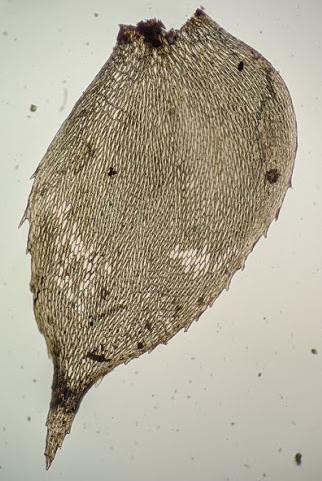Cyathophorum
Dioicous. Asexual reproduction by filamentous gemmae borne on stems toward apices. Loosely gregarious to isolated stems arising from soil, rocks, logs, tree fern or tree trunks, sometimes submerged. Stems simple, occasionally branched, not differentiated into stipe and rachis sections, tomentose at base, terete or quadrangular; central strand present. Leaves complanate, in three ranks, markedly dimorphic with ventral rank smaller and differing in shape from two lateral ranks; lateral leaves patent to widely patent, weakly wrinkled to twisted or strongly crisped when dry, asymmetric; ventral leaves appressed to patent, symmetric; costa simple or forked, extending to ½ leaf length; hairpoint absent; margins entire to serrate, with a faint to distinct and often interrupted border of more elongated cells; laminal cells hexagonal, rhomboid-elliptic or short-linear, porose, thin-walled. Setae borne abaxially, directed downwards, smooth. Capsules erect, straight. Calyptra mitrate, fleshy, pale to dark brown, glabrous. Operculum rostrate from conic base. Peristome double; exostome of 16 entire teeth; endostome of 16 processes; cilia absent or present.
Four species occurring from Nepal to Japan, east to French Polynesia and south to New Zealand; one species in Victoria.
Two species (C. hookerianum (Griff.) Mitt. and C. parvifolium Bosch & Sande Lac.) from Asia and Malesia respectively with cucullate calyptra were transferred to Hypopterygium, given that they are nested within Hypopterygium based on phylogenetic analyses of nuclear and chloroplast DNA sequences (Shaw et al. 2008). Cyathophorum africanum Dixon, was also misplaced in Cyathophorum given that it too has a cucullate calyptra and is most closely related to Dendrohypopterygium decolyi (Broth. ex. M. Fleischer) Kruijer (Kruijer & Blöcher 2007).
 Spinning
SpinningKruijer, H. (2002). Hypopterygiaceae of the world. Blumea supplement 13: 1–388.
Kruijer, H. (2006). Hypopterygiaceae, in McCarthy, P.M. (ed.), Flora of Australia, vol. 51, pp. 377–388.. ABRS and CSIRO, Canberra and Melbourne.
Kruijer, H.; Blöcher, R. (2007). Reevaluation of the phylogeny of the Hypopterygiaceae (Bryophyta) based on morphological and molecular data, in Newton, A.E. & Tangney, R.S. (eds), Pleurocarpous mosses. Systematics and Evolution, pp. 61–103. CRC Press, Boca Raton.
Shaw, A.J.; Holz, I.; Cox, C.J.; Goffinet, B. (2008). Phylogeny, character evolution, and biogeography of the Gondwanic moss family Hypopterygiaceae (Bryophyta). Systematic Botany 33: 21–30.

